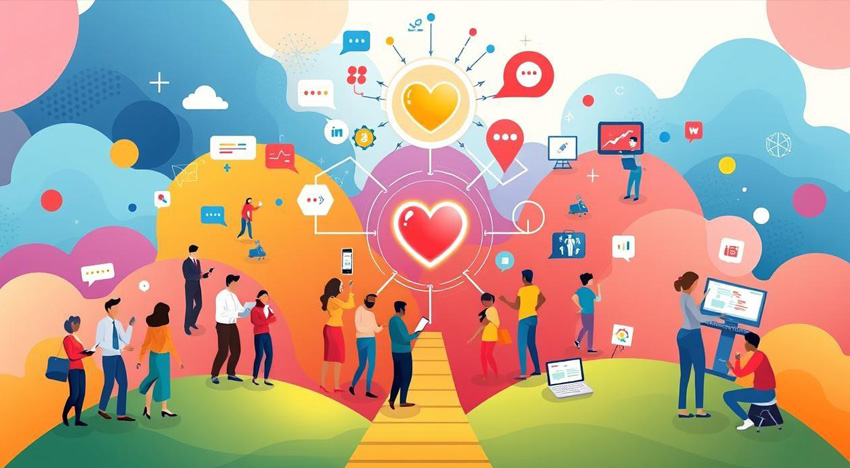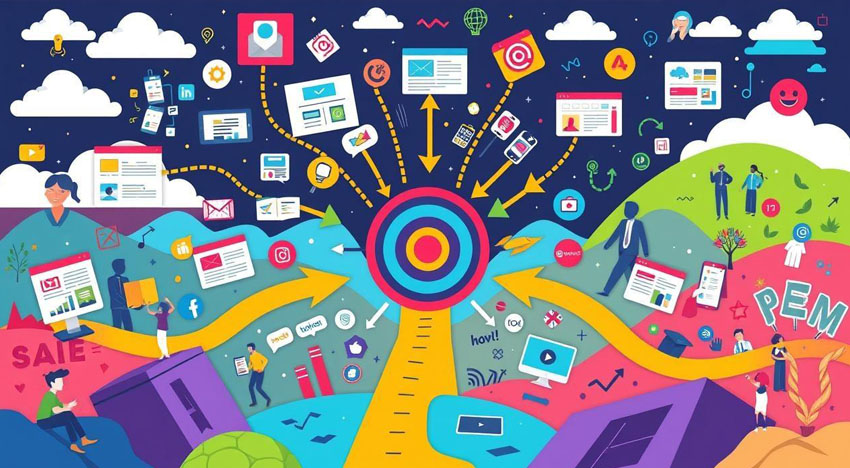The buyer’s journey is a key concept. It explains how customers decide to buy things. It includes three main parts: Awareness, Consideration, and Decision. Each part is crucial for a good customer experience. Aligning a sales process with this journey is vital for better selling and happier customers. By matching your sales process with the buyer’s journey, win rates go up and customer bonds grow stronger.
By syncing your sales plan with this journey, you provide the right info at key moments. This personalizes the customer experience. A personalized sales approach boosts your chance of making a sale. Moreover, understanding and mapping the buyer’s journey focuses on the customer. It solves their problems and meets their needs better.
Key Takeaways
- The buyer’s journey consists of three stages: Awareness, Consideration, and Decision.
- Aligning your sales process with the buyer’s journey enhances sales effectiveness.
- Personalized sales experiences significantly boost conversion rates.
- Understanding customer needs and pain points can improve customer satisfaction and retention.
- Providing relevant information at each stage of the journey is crucial for higher conversion rates.
Understanding the Buyer’s Journey and Its Importance
The buyer’s journey has three big steps: Awareness, Consideration, and Decision. Knowing these steps helps businesses make strategies that connect with customers, helping them buy more easily. By matching marketing to each step of the buying journey, companies improve the shopping experience and get better results.

Stages of the Buyer’s Journey
The journey starts with Awareness, when people realize they have a problem and look for potential solutions. About 70% of their research happens before they even talk to a supplier. This shows why it’s so important for businesses to have helpful content to grab their interest.
Next comes the Consideration stage. Here, buyers look at what different products or services can do for them. They want detailed info like guides and studies to help them choose. Finally, in the Decision stage, people are ready to buy but might want a demo or trial first.
The customer buying process can take days, weeks, or months before committing to a purchase.
Key Consumer Behaviors to Consider
Understanding how customers behave helps a lot in turning leads into sales. Research says 74% of buyers check out at least three sources before choosing. Showing them useful information across various places can help sway their purchase decision. Also, things like looking for advice from friends, comparing brands, and wanting detailed product info are big factors in their decisions. About 82% of them expect companies to understand what they want at every step, showing how key personalized content is.
- Acknowledging the need for information – Mostly seen in the Awareness stage.
- Comparing solutions – Found in the Consideration stage, where detailed insights are needed.
- Final decision-making – Happens in the Decision stage, where things like demos are crucial.
Properly mapping the buyer’s journey can boost conversion rates by up to 50%. Additionally, companies that keep in touch with potential customers increase sales productivity by 50%. So, investing time in understanding and optimizing the journey steps is crucial for businesses today.
The Role of Sales Alignment in Modern Business
Sales alignment is key for the decision making process to make sure teams work together well. This boosts sales greatly. Nowadays, buyers know a lot thanks to easy access to information. This makes buying more complex.

Enhancing Team Collaboration
Working together as a team is crucial for handling buyers well. Teams need 6 to 10 tries to reach a B2B buyer. More efforts are needed to complete a sale. Teams working in sync ensure every interaction helps the buyer along.
A better team work approach helps sales professionals tackle buying difficulties. A study by Gartner found that 77% of buyers think buying is complex or tough.
“Effective alignment of team efforts ensures that all interactions are targeted and well-coordinated, significantly aiding in converting potential leads into loyal customers.”
Benefits of a Unified Approach
Having a single sales strategy has many perks. More than 90% of buyers stick to known vendors. This shows the importance of a united strategy to be a top choice. It lowers team conflicts and improves sales and service.
Also, B2B sellers mostly do warm calls (90%). This highlights the need for a united approach in reaching prospects.
- Boosts sales rep effectiveness and customer satisfaction through well-aligned processes.
- Facilitates a seamless transition from buyer interest to purchase by ensuring all team members are on the same page.
- Enhances digital sales aids such as playbooks, which streamline processes and improve rep performance.
In conclusion, aligning your sales efforts through teamwork and a single strategy has big benefits. As buying gets more complex, good sales alignment becomes key. It helps your sales managers achieve not just more sales but also happier customers.
| Key Metrics | Statistics |
| Touches Needed to Connect with Buyer | 6-10 |
| Percentage of Buyers with Pre-Existing Vendor Lists | 80-90% |
| Percentage of Buyers Describing Purchases as Difficult | 77% |
| Preference for Communication Channels | Social Media: 46.5%, Email: 72.1%, Phone: 55.8% |
Creating a Customer-Centric Strategy
Putting your customers first is key in a customer-centric strategy. This means personalized marketing and offers that speak directly to them. This approach boosts satisfaction and loyalty. Companies that focus on what customers need and want tend to do better. They see more profits and their brands shine.
Defining Customer Needs and Pain Points
Knowing what your customers need and what troubles them is crucial. It involves learning about their likes, problems, and what they expect. A survey by PwC found that 73% of people think customer experience is important in their buying choices. Getting into the details of their issues lets you cater to them in a personal way.

Tailoring Messaging and Offers
Understanding your customers lets you shape your messages and offers to fit them. Personalized marketing is key in reaching out in a way that resonates. By tailoring what you say and offer, engagement with customers goes up. HubSpot’s report shows that 31% of customer service leaders aim to boost loyalty and keep customers coming back.
Focusing on your customers in your business model brings many benefits. According to Deloitte, customer-focused companies are 60% more profitable and keep their customers longer. It’s important to make sure marketing and sales work together. This way, customers get consistent, personal experiences that build lasting bonds.
| Benefit | Impact |
| Increased Profitability | 60% more profitable |
| Enhanced Customer Loyalty | 93% loyalty rate at Apple |
| Customer Retention | 42% increase in retention |
| Improved Customer Satisfaction | 33% increase |
A customer-centric strategy is essential today. By meeting customer needs and making relevant offers, you develop a formula for success. This strategy doesn’t just draw people in. It keeps them, ensuring your business thrives over time.
Researching Your Target Audience Effectively
Understanding your target audience deeply is key to marketing success. You need to segment the market and use different techniques for valuable insights. This way, your marketing is on point and impactful.
Utilizing Market Segmentation
Segmenting your market means grouping your audience based on common traits. It helps tailor your strategies to their needs and likes. About 67% of middle market firms use segmentation in their strategies.
To segment effectively, look at demographics, psychographics, and buying behaviors. This lets you design marketing that strikes a chord with various consumer drives. It also boosts your chances of making a sale.

Techniques for Gathering Customer Insights
Knowing your audience well is crucial. You can use surveys, focus groups, and customer data analysis. Surveys provide direct responses, while focus groups delve into deeper preferences and behaviors.
Analyzing data with CRM tools can make your communication highly personal. This improves lead conversion significantly, by up to 67%.
Here’s a look at how these techniques compare:
| Research Technique | Purpose | Effectiveness |
| Surveys | Collect direct feedback | High |
| Focus Groups | Gain in-depth customer insights | Medium |
| CRM Data Analysis | Personalize communication | Very High |
Using these methods helps you understand your audience fully. This lets you customize your messages and offers. Meeting their needs increases your chances of turning leads into loyal customers. Always analyze and adapt based on these insights to stay relevant. The market is always changing.
Mapping the Buyer’s Journey: Step-by-Step
Understanding your customer’s journey is essential. It involves mapping each stage from their point of view. This map not only shows buyer touchpoints but also helps improve these interactions. By focusing on these touchpoints, you can make the buyer’s experience better and increase your revenue.
Identifying Touchpoints
To track the buyer’s journey well, start by finding key touchpoints. These touchpoints, from first awareness to after the buying decision, tell you a lot about what customers like. Gartner says B2B buyers only spend 17% of their buying time with sellers. So, knowing these touchpoints helps you connect with customers better.
- Awareness Stage: Buyers see their issues or goals. Give useful info to start a good relationship.
- Consideration Stage: Consumers look at options. Use e-books and comparison matrices to help them.
- Decision Stage: Buyers want detailed info like case studies or pricing. Offering clear and full details is key.
- Delight Stage: After buying, support like user guides keeps buyers happy.
Creating a Visual Map
Creating a visual map helps understand customers’ paths. These maps show where you can get better in the sales cycle. Documenting milestones in this journey makes every interaction better. Always communicate well and set clear expectations for happy customers.
| Stage | Key Activities | Content Suggestions |
| Awareness | Recognize problems/goals | Blogs, infographics |
| Consideration | Evaluate solutions | E-books, comparison charts |
| Decision | Assess vendor options | Case studies, testimonials |
| Delight | Support and retention | User guides, webinars |
Spending time to map the buyer’s journey correctly is vital. It helps businesses see where they need to better understand customer experiences. Good customer journey mapping means better ROI, more revenue, and happier customers. Aligning marketing and sales with journey data makes the buying and selling process more smooth and enjoyable.
Designing Tailored Content for Each Stage
Content marketing works best when it fits each stage of the buyer’s journey. We’ll explore content for the awareness stage and strategies for the consideration stage. This helps connect with and guide your audience the right way.
Awareness Stage Content Ideas
In the awareness stage, aim to educate and introduce your brand. Avoid direct sales talk. Your content should be useful and meet your audience’s own initial research needs.
Here are some ideas:
- Blog Posts: Address common issues and challenges in your industry. “How to Improve Team Productivity” could help those seeking solutions.
- eBooks: Offer deep analysis on relevant topics. An eBook like “The Future of Remote Work” can position you as a thought leader.
- Case Studies: Show real examples of how you solved customer problems, proving your expertise.
- White Papers: Provide detailed reports on complex issues. “Adopting Cloud Solutions in Small Businesses” can generate interest.

About 70% of the buyer’s journey happens before prospects even talk to sales. This shows how crucial it is to have content that meets their needs early on.
Consideration Stage Strategies
At the consideration stage, buyers are looking at their choices and comparing solutions. Your content should go deeper, showcasing how your offerings are better and answering potential objections.
Here are strategies:
- FAQs: Offer detailed FAQs that tackle common queries. This builds trust and gives vital info early on.
- Product Brochures: Highlight your offerings’ main features and benefits in brochures.
- Explainer Videos: Videos can quickly convey complex info. 70% of B2B buyers view three or more videos before making a decision.
Stats show companies good at lead nurturing generate 50% more sales-ready leads at 33% less cost. Plus, 53% of buyers want more content when considering a purchase. So, offering plenty of materials at this stage is crucial.
Using the right content marketing strategies for each stage of the sales funnel helps attract and convert prospects throughout their journey.
Tools to Enhance Customer Journey Mapping

Customer journey mapping is key to a good customer experience. Tools like CRM software and analytics are important. They help use real-time data and insights to improve your strategy.
CRM Software Solutions
CRM software is crucial for better interactions with customers and prospects. It keeps customer data in one place. This helps track and manage the journey from first contact to after the sale.
Here’s how CRM software can be beneficial:
- Centralized Data: With all customer information in one place, it’s easier to access and utilize data effectively.
- Improved Customer Engagement: CRM tools help provide personalized experiences, which 63% of consumers expect.
- Enhanced Team Collaboration: Nearly 80% of employees who created a customer journey map said it helped generate alignment between internal teams.
- Increased Customer Satisfaction: Companies that effectively map the customer journey see an average increase of 10-15% in customer satisfaction scores.
Analytics Tools for Buyer Insights
Behavioral analytics and journey tools are key for understanding customer actions. They offer insights that help refine your strategy and meet customer needs.
| Benefits | Details |
| In-depth Insights | Analytics tools reveal how customers interact with your brand, helping you tailor the experience to meet their expectations. |
| Behavioral Analytics | Tracking consumer behaviors allows you to predict future actions and personalize marketing efforts effectively. |
| Enhanced User Experience | Over 70% of organizations say customer journey mapping has helped them improve user experience (UX) and secure investment for new features. |
| Stakeholder Education | 81% of CX practitioners agree that journey mapping educates stakeholders about consumer pain points and unmet needs. |
By using CRM and analytics, businesses can get a full view of the customer journey. This improves satisfaction, boosts revenue, and enhances loyalty. It shows the value of combining customer journey tools.
Measuring Success Through KPIs
To better your sales process, use Key Performance Indicators (KPIs). They are key for refining your operations and aligning them with your goals. You need to know which metrics matter and how using data helps in making better decisions.

Essential Metrics to Track
Tracking different performance metrics is vital to understand your progress. Some key KPIs include: customer churn rate, Net Promoter Score (NPS), Customer Satisfaction Score (CSAT), engagement level, and average shopping cart abandonment rate. These help identify areas for improvement.
- Customer churn rate—measures the percentage of customers who stop subscribing to a service over a specific time period.
- Net Promoter Score (NPS)—assesses customer loyalty with a lower score indicating a need for improvement.
- Customer Satisfaction Score (CSAT)—provides insight into whether the company has met or exceeded customer expectations.
- Engagement level—enhanced customer experience on-site can lead to increased engagement time from visitors, suggesting content relevance and appeal.
- Average shopping cart abandonment rate—at 68.53%, according to the Baymard Institute, offers insight into potential areas for improvement in the purchasing process.
Analyzing Data for Continuous Improvement
After setting the right KPIs, it’s crucial to analyze the data. This helps continually improve and make informed decisions. Start by identifying where you can do better.
For example, the Zendesk Trends Report shows that fast solutions are key for good service. Also, most customers will pay more for great service. These facts show how crucial customer service is for keeping people happy and loyal.
Checking your KPI data often lets you quickly adjust strategies to match trends. In turn, this focus on data-driven decisions can increase and improve sales performance and customer loyalty.
| Metric | Importance | Statistics |
| Customer churn rate | Identifies subscriber retention issues | Calculated as the percentage of customers who stop subscribing over a specific period |
| Net Promoter Score (NPS) | Evaluates customer loyalty and perception | Lower scores indicate a need for improvement in customer perception |
| Customer Satisfaction Score (CSAT) | Measures if customer expectations are met or exceeded | High CSAT often correlates with improved retention rates |
| Average shopping cart abandonment rate | Defines potential friction points in purchasing | According to the Baymard Institute, the average rate is 68.53% |
| Engagement level | Assesses the attractiveness and relevance of on-site content | Enhanced experiences lead to longer visitor engagement times |
Training Your Sales Team on the Buyer’s Journey
Teaching your sales team about the buyer’s journey is key for success. It’s important to know each stage well and tailor your team’s approach. High-performing salespeople stay ahead, even when the buyer’s journey typically consists of changes. We will look at important areas and how role-playing can improve skills.
Key Areas of Focus
The stages of the buyer’s journey, like Awareness, Consideration, and Decision, are core concepts. Buyers often lead the way, sometimes skipping stages. Training should help your team adjust to these changes smoothly.
Focus on these areas:
- Proactive Engagement: Meet the buyer’s needs early.
- Resource Utilization: Use case studies and tools like ROI calculators well.
- Feedback Integration: Use advice from top salespeople to get better.
Role-Playing Scenarios
Running role-playing training boosts your team’s readiness. It lets them practice dealing with questions and objections. This makes sales interactions more successful. Putting these scenarios in different stages of the buyer’s journey makes training even better.

Here’s how a great role-playing exercise looks for each buyer journey stage:
| Stage | Role-Playing Scenario | Objective |
| Awareness | Identifying and addressing initial pain points | Help the buyer become aware of solutions |
| Consideration | Discussing features and benefits | Help compare options and share detailed product info |
| Decision | Handling objections and closing the deal | Resolve concerns and get commitment |
Using these techniques in your buyer’s journey training will make your sales approach more buyer-focused. Engaging buyers at all stages meets their changing needs. It keeps your team flexible in a changing market.
FAQ
What is the buyer’s journey and why is it important?
The buyer’s journey is the process customers follow to buy something. It has three parts: Awareness, Consideration, and Decision. By understanding this, businesses can better meet customer needs. This improves sales and customer experiences.
How does sales alignment improve the sales process?
Aligning the buyer aligned sales process with the buyer’s journey boosts win rates and personalizes customer experiences. It helps understand customer needs and objections. This way, businesses can connect better, increasing sales.
What are the key stages of the buyer’s journey?
The buyer’s journey has three main stages. First is Awareness, where buyers realize they have a need. Next is Consideration, where they look at options. Last is Decision, where they buy.
How can understanding consumer behavior enhance lead generation?
Knowing how consumers behave is key to better lead generation. It lets businesses create strategies that meet consumer expectations. This makes marketing more focused and effective.
What role does sales alignment play in modern businesses?
Sales alignment means coordinating team efforts for smooth operations. It leads to better sales and customer service. Teams work together better and handle buyers concerns more effectively.
Why is a customer-centric strategy crucial in business?
A customer-centric strategy puts customer needs first in product and service design. It identifies and addresses customer pain points. This approach improves customer loyalty and engagement.
What techniques can be used for effective target audience research?
For audience research, use market segmentation, surveys, focus groups, and customer data analysis. These methods offer insights into preferences and behaviors. They help tailor marketing to specific groups.
How can marketing and sales teams align their efforts?
To align efforts, marketing and sales teams should set shared goals and exchange insights. This ensures they work towards the same objectives. It improves efficiency and lead conversion.
What are the steps involved in mapping the buyer’s journey?
Mapping includes identifying where customers engage with the brand, from first awareness to after buying. A visual map of these points helps understand and improve interactions.
How can content be tailored for each stage of the buyer’s journey?
Content in the Awareness stage should introduce the brand. In Consideration, it explains how the brand solves problems. This prepares buyers for the Decision stage.
What tools can enhance customer journey mapping?
CRM and analytics tools are vital for understanding customer interactions and behavior. They refine marketing strategies, ensuring they match customer needs.
What KPIs are essential for measuring the success of buyer’s journey mapping?
To measure success, look at conversion rates, customer satisfaction, and engagement. These KPIs help pinpoint where to improve sales and marketing.
How can you train your sales team on the buyer’s journey?
Training should cover each journey stage and how to interact in each. Role-playing helps practice handling real customer situations effectively.
How can continuous improvement be achieved in the buyer’s journey?
Use customer feedback for ongoing adjustments to meet changing needs. Always refine sales and marketing based on metrics and feedback for continuous customer success too.
References
- Aligning Your Sales Process to the Buyer’s Journey – https://blog.thecenterforsalesstrategy.com/aligning-your-sales-process-to-the-buyers-journey
- How to Align Your Sales Process with the Buyer’s Journey – https://brooksgroup.com/sales-training-blog/how-align-your-sales-process-buyers-journey/
- Step-by-step guide to mapping the buyer’s journey | Cart.com – https://cart.com/blog/mapping-buyers-journey-and-measuring-customer-experience
- What is the buyer’s journey? Definition, stages, and examples – https://www.zendesk.com/blog/buyer-journey/
- Buyer’s Journey – https://dealhub.io/glossary/buyers-journey/
- Aligning Sales & Marketing for the Evolving Buyer’s Journey | WorkRamp – https://www.workramp.com/blog/aligning-sales-and-marketing/
- Align Your Sales Process with the Buyer’s Journey – https://bigbusinessagency.com/insights/align-your-sales-process-with-the-buyers-journey
- The Ultimate Guide to Creating a Customer-Centric Strategy for Your Business – https://helpjuice.com/blog/the-ultimate-guide-to-creating-a-customer-centric-strategy-for-your-business
- How to Create a Customer Centric Strategy For Your Business – https://www.superoffice.com/blog/how-to-create-a-customer-centric-strategy/
- How To Implement A Customer-Centric Strategy – https://predictablerevenue.com/blog/how-to-implement-a-customer-centric-strategy/
- Aligning Strategy with the Buyer’s Journey | Craig Group – https://www.craiggroup.io/houston-expert-why-you-need-to-align-your-strategy-with-your-buyers-journey/
- Understanding the Buyer’s Journey: Mapping Your Marketing Strategy – https://www.nobledesktop.com/learn/digital-marketing/understanding-the-buyers-journey-mapping-your-marketing-strategy
- How to Optimize Your Buyer’s Journey – Conversion Made Easy | 97th Floor – https://97thfloor.com/articles/glossary/buyer-journey/
- 7 Steps to Achieving Sales and Marketing Alignment – https://www.highspot.com/blog/sales-and-marketing-alignment/
- 9 Steps to Align Sales and Marketing Teams – Madison Logic – https://www.madisonlogic.com/blog/how-to-align-sales-and-marketing/
- The complete guide to sales and marketing alignment – https://sopro.io/resources/blog/complete-guide-sales-marketing-alignment/
- How to Map the Buyer’s Journey (aka the Customer Journey) – https://www.harvestroi.com/growth-blog/mapping-the-buyers-journey
- Mapping the customer sales journey: Making sales buyer-centric | SEC – https://www.salesenablementcollective.com/customer-journey-mapping-making-sales-buyer-centric/
- How to Align SaaS Marketing Content with the Buyer’s Journey – https://www.kalungi.com/blog/saas-buyers-journey-marketing-funnel
- How to Map Your Content to Each Stage of the Buyer’s Journey – https://www.foleon.com/blog/how-to-map-your-content-to-the-buyers-journey
- Level Up Your Content Marketing Funnel — Here’s How I Make the Right Content for Each Stage – https://blog.hubspot.com/marketing/content-for-every-funnel-stage
- Customer Experience Journey Mapping Tips & How To | InMoment – https://inmoment.com/blog/customer-journey-mapping/
- Mastering How to Create Customer Journey Map: Tips & Examples | NICE – https://www.nice.com/info/mastering-how-to-create-customer-journey-map-tips-and-examples
- Top 10 customer experience KPIs and metrics for 2024 – https://www.zendesk.com/blog/10-customer-experience-kpis/
- Connecting Your Sales Process to the Buyer’s Journey – https://www.highspot.com/blog/connecting-your-sales-process-to-the-buyers-journey/
- Enabling Sales Teams Through the Buyer’s Journey | Richardson Sales Performance – https://www.richardson.com/en-gb/blog/enabling-sales-buyer-journey/
- Aligning Sales with the way customers buy – https://dealhub.io/blog/sales/aligning-sales-with-the-way-customers-buy/
- Creating a Buyer-Centric Sales Journey Process – https://www.activatedscale.com/blog/sales-journey-process-creation
- What Is the Buyer’s Journey — and Why Should You Care About It? – https://www.salesforce.com/blog/buyer-journey/
- Aligning CRM Implementation with the Buyer’s Journey – https://www.mxmoritz.com/article/aligning-crm-implementation-with-the-buyers-journey







